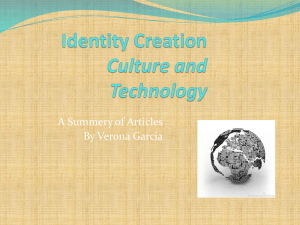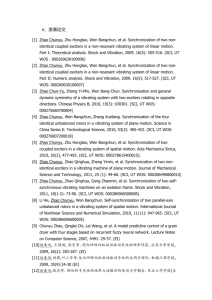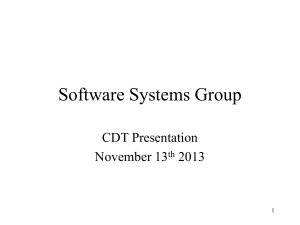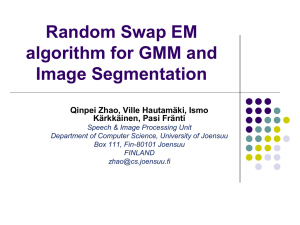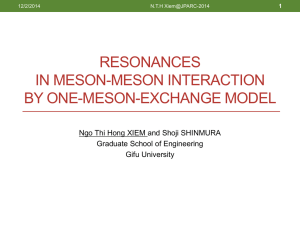Slide 1 - ihep.ac.cn
advertisement
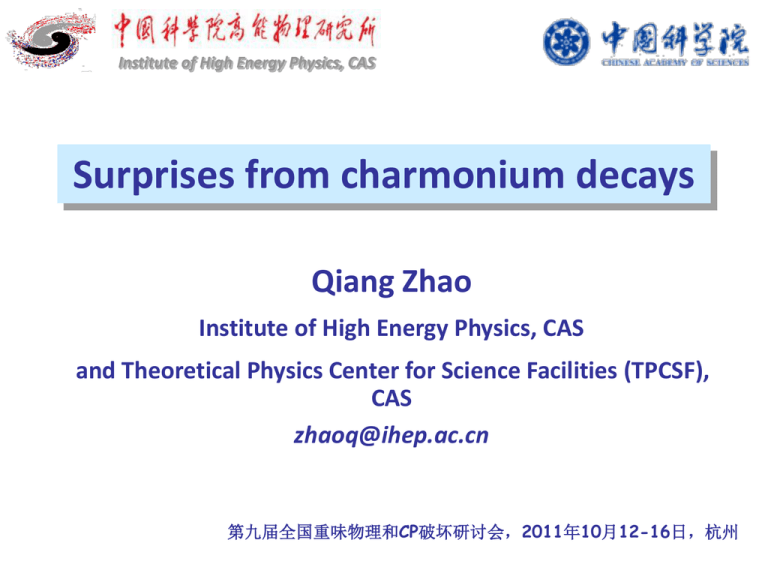
Institute of High Energy Physics, CAS Surprises from charmonium decays Qiang Zhao Institute of High Energy Physics, CAS and Theoretical Physics Center for Science Facilities (TPCSF), CAS zhaoq@ihep.ac.cn 第九届全国重味物理和CP破坏研讨会,2011年10月12-16日,杭州 Outline 1. Charmonium and charmonium-like states 2. Direct evidence for open charm threshold effects in e+e- J/, J/ 0, and c 3. Puzzles in charmonium decays 4. Summary • Recent experimental progress New charmonium-like states, i.e. X, Y, Z’s, are observed in experiment • Do not fit in the conventional charmonium spectrum as quark-antiquark states. • Most of these new states, such as X(3872), are located close to a two-particle threshold. • Evidence for charged charmonium states, e.g. Z(4430). • Good candidates for hadronic molecules or other nonstandard configurations, e.g. tetraquarks, hybrids, etc. • Greatly enrich our knowledge about strong QCD. Charged charmonium spectrum -- A completely new scenario of strong QCD! States close to open thresholds -- The role played by open D meson channels? Close to DD* threshold S=0,1 c L c J=L+S 1010.5827 [hep-ph] Observation of X(3872) new Belle meas. <MX>= 3871.46 ± 0.19 MeV new CDF meas. MD0 + MD*0 3871.8±0.4 MeV dm = 0.35 ± 0.41 MeV • The mass of X(3872) does not fit in (cc) 1++ state of quark model • Small mass difference to DD* threshold • Large isospin-violating decay modes • JPC = 2 is not ruled out Nature of X(3872) • A good candidate for hadronic molecule (Tornqvist 1991) BX = 0.35 ± 0.41 MeV • The compositeness criterion can be applied • Tremendous contributions from theory commu. A B C . . . Z Proton u d u d d Neutron u Deuteron: p-n molecule Charged charmonium-like states S.K. Choi et al., PRL 100,142001 (2008) • Resonant structure Z(4430) – – – – Close to D*D01 threshold Q = 1, JP= 0,1,2 M= 4433 MeV = 45 MeV First direct evidence for an exotic quark configuration, i.e. (cc ud). arXiv:1105.4583[hep-ex] Look for direct evidence for open charm threshold effects: 1) Spectrum studies 2) Production and decay processes (e.g. e+e- J/, J/ 0, c ) 1010.5827[hep-ph] X(3900) Close to DD* threshold i) Charmonium production in ee final particles * 1, … e Belle, BaBar, and BEPC-II …… e+ • Direct production of vector charmonium states • Dynamics for charmonium interactions with final states • Signals for exotics? X(3900)? • Open charm effects in the cross section lineshape studies e+e- DD • What is X(3900)? • Not inlcuded in PDG2010. • Not in charmonium spectrum •…… Pakhlova et al., Belle Colla., PRD77, 011103(2008). Y.-J. Zhang and Q. Zhao, PRD81, 034011 (2010) e+e- DD e+e- DD* + c.c. DD* open threshold may explain: Y.J. Zhang and QZ, PRD81, 034011 (2010) ii) Direct evidence for open charm effects in ee J/ , J/ 0 (3770) J/ (I=0) D0 (3770) (I=0) D D0 (I=0) 0 (I=1) (b) (a) J/ (I=0) D* D*0 (I=0) 0 (I=1) For the isospin-violating J/0 production: If mu = md , m(D0) = m(D) (a) + (b) = 0 If mu md, m(D0) m(D) (a) + (b) 0 • Cross section lineshape of e+e J/ • Direct evidence for open charm effects in the cross section lineshape of e+e J/ 0 ~ 8 MeV Wang, Liu, Zhao, 1103.1095[hep-ph], PRD84, 014007(2011) • Possible further evidence for open charm effects in the cross section lineshape of e+e c Puzzles in charmonium decays “ puzzle” in J/, VP decay (3770) non-DD decay M1 transition problem in J/, c, ( c) Recent puzzling results for J/, , Large c (c) VV branching ratios Decays of c1 VV and c2 VP Isospin-violating decay of (3770) and J/ 0, and hc0 Conjecture: 1) Could These puzzles could … be related to non-pQCD mechanisms in be more … charmonium decays due to intermediate D meson loops. 2) The intermediate meson loop transition could be a mechanism for the evasion of the helicity selection rule. “-疑难”和(3770)的非D介子衰变 • QCD理论可以在J/和衰变之间建立起一个简单的关系: c g c J/, ' c * J/, ' c 强衰变 • J/, 衰变严重 偏离这一“12%法则”: R() = 电磁衰变 0.2 % c • 实验观测的矛盾: g (3770) BES-II发现(3770) 的非D介子对衰变分 支比约为15%;而CLEO-c发现这一衰变 分支比几乎可以忽略(上限约为9%)。 c 非D介子对 强衰变 • 微扰QCD理论计算发现: [He, Fan, and Chao, PRL101, 112001 (2008)] 非相对论QCD领头阶的计算与CLEO-c的结果一致,但是次领头阶的修正 却极为重要,可以给出约为5%的分支比。 暴露出的问题: QCD非微扰机制在粲偶素能区可能变得极为重要! DD衰变阈会通过与“非淬火”效应相关的D介子圈影响(3686) 的衰 变性质,特别是压低 的强衰变振幅强度;同时导致(3770)的 非D介子对衰变的非微扰跃迁。 (3770) (3770) c cD 粲 偶 素 质 量 D(cq) (ud) c c D (3770) DD 衰变阈 (3686) D (ud) D (3686) (du) c c J/(3096) JPC D(qc) (du) = 1 (3770) 通过D介子圈衰变到非D介子对末态的 非微扰跃迁机制 可以合理解释(3770)较大的非D介子衰变分支比! Y.-J. Zhang, G. Li and Q. Zhao, Phys. Rev. Lett. 102, 172001 (2009) Mechanism suppressing the strong decay amplitudes of VP Open-charm effects as an OZI-rule evading mechanism J/ () c g V J/ () c D V D* c* SOZI: pQCD dominant P c D P OZI-evading: non-pQCD dominant • Interferences among the single OZI, EM and intermediate meson loop transitions are unavoidable. Decomposition of OZI evading long-range loop transitions D D J/ () J/ () D D* D t-channel J/ () … V s-channel Zhang, Li and Zhao, 0902.1300[hep-ph]; Li and Zhao, PLB670, 55(2008) Recognition of interferences Property of the anti-symmetric tensor coupling allows a parametrization: Overall suppression of the strong decay coupling: In order to account for the “ puzzle”, a destructive phase between and is favored. Zhao, Li, and Chang, JPG2009 Preliminary results The same mechanism should contribute in various processes involving the same charmed meson loops Nonrelativistic quark model: Isgur et al. GI: Godfrey and Isgur Lattice results: Dudek et al., PRD79, 094504 (2009) Li and Zhao: PLB670, 55 (2008); PRD84, 074005 (2011) Summary • Surprises from higher charmonium states could be signals for nonperturbative mechanisms due to open charms. • Open charm effects could be essential for understanding some of those long-standing puzzles in charmonium decays (3770) non-DD decays “ puzzle” in J/, ’ VP M1 transition problem in J/, c, ( c) Isospin violating decay of and (3770) J/0 Helicity selection rule violations (c1 VV, c2VP, c BB …) Cross section lineshapes of e+e- DD and DD*+c.c. …… • Lots of opportunities for experiments accessible this energy region, such as BES-III, Panda, Super-B … To firm up open charm effects … 1) Look for systematic constraints on the model uncertainties in all relevant processes. 2) Look for effects of hadronic loop contributions as unquenched effects in charmonium spectrum (refs.: T. Barnes and E. Swanson, PRC77, 055206 (2008); Li, Meng and Chao, PRD80, 014012(2009) 3) Compare different theoretical approaches, e.g. NREFT and ELA in isospin-violating charmonium decays. (refs.: Guo, Hanhart, and Meissner, PRL(2009); Guo, Hanhart, Li, Meissner, QZ, PRD(2010); and PRD(2011).) Part of relevant references: 1. G. Li and Q. Zhao, Phys. Rev. D 84, 074005 (2011), arXiv:1107.2037[hep-ph]. 2. Q. Wang, X.-H. Liu and Q. Zhao, Phys. Rev. D 84, 014007 (2011). 3. Q. Zhao, Phys. Lett. B 697, 52 (2011). 4. F.-K. Guo, C. Hanhart, G. Li, Ulf-G. Meißner, Q. Zhao, Phys. Rev. D 83, 034013 (2011); arXiv:1008.3632[hep-ph]. 5. X.-H. Liu and Q. Zhao, J. Phys. G 38, 035007 (2011); arXiv:1004.0496 [hepph]. 6. F.-K. Guo, C. Hanhart, G. Li, Ulf-G. Meißner, Q. Zhao, Phys. Rev. D 82, 034025 (2010); arXiv:1002.2712[hep-ph]. 7. X.-H. Liu and Q. Zhao, Phys. Rev. D 81, 014017 (2010) 8. Y.J. Zhang, G. Li and Q. Zhao, Phys. Rev. Lett. 102, 172001 (2009); arXiv:0902.1300 [hep-ph]. 9. Y.-J. Zhang and Q. Zhao, Phys. Rev. D81, 034011 (2010) 10. Y.J. Zhang and Q. Zhao, Phys. Rev. D 81, 074016 (2010) 11. Q. Zhao, G. Li and C.H. Chang, Chinese Phys. C 34, 299 (2010); 12. G. Li and Q. Zhao, Phys. Lett. B 670, 55(2008). 13. G. Li, Q. Zhao and C.H. Chang, J. Phys. G 35, 055002 (2008) 14. Q. Zhao, G. Li and C.H. Chang, Phys. Lett. B 645, 173 (2007) Thanks for your attention! Anomalously large isospin violations: BESIII@Hadron2011 • Theoretical interpretation: Wu, Liu, Zhao and Zou, arXiv: 1108.3772[hep-ph] Triangle singularity a0-f0 mixing To pin down the underlying dynamics Direct test of rho-pi puzzle: • J/, PP for the role played by EM annihilations (X.Q. Li) • c, c VV for the role played by strong annihilations (Wang, Liu, QZ) Indirect tests: • Helicity selection rule violation processes and correlations with the OZI rule violations (Liu et al; Liu, Wang, QZ) • Strong isospin violations via charmed meson loops (Guo, Hanhart, Li, Meissner, QZ) • Open charm effects in the cross section lineshape studies • B meson loops in Upsilon decays (Chao et al) • Open threshold effects on the charmed meson spectrum (Barnes et al; Chao and Meng)



